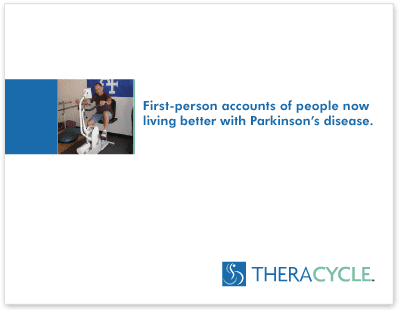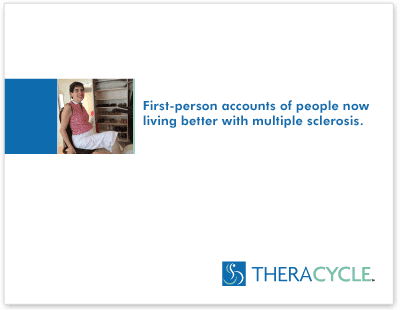- ›
- Stories
- ›
- Your Stories
- ›
- The Benefits of Weightlifting for Individuals with M.S.
Stories
The Benefits of Weightlifting for Individuals with M.S.
You may have already “met” Mariana (our friend and 6-year veteran Theracycle rider) who shared her own Theracycle Story in a prior post….
Since it’s been something that she really enjoys and gets great benefits from – Mariana’s written the article below “The Joys of Weight Lifting— Despite M.S.”
If you’re someone with mobility challenges who’s considering adding weight training to your exercise routine, you’ll find Mariana’s article a helpful primer in what to look for.
Since she’s “been there, done that” – her article provides some “tricks of the trade” and personal insights on exercises and equipment that have worked for her.
I think you’ll agree with me that Mariana’s words are both instructive and inspiring!
The Joys of Weight Lifting… Despite M.S.
By Mariana
One of the best things I have done for myself as a person with M.S. is to self-prescribe weight-lifting as part of my exercise routine. Exercise has always been an important part of my life, for fun as well as for relieving stress and staying in shape. As my body has changed with M.S., however, I have needed to adjust my work-out plan to adapt to my changing abilities.
For almost 4 years now I have used weight-training equipment at one of several gyms in my area (I have alternated which one I attend, for variety). I go to the gym three mornings a week, following the weight-lifter’s rule of exercising on alternate–not consecutive–days. I supplement this exercise at home by daily riding a stationary “bicycle” (Theracycle). I chose weight-training because I hoped that some of the many (non-motorized) “machines” available would help me exercise my legs in different ways. I was ambulatory–just barely. I hoped that exercise would help me maintain as much mobility as possible.
I am pleased to report that my explorations have proved beneficial. With the assistance of certified weight-trainers, I have been able to exercise all of my major muscle groups and to build valuable strength in my arms. My body feels so much more alive during and after exercise, that motivation to go to the gym has never been a problem. I have even been able to target certain challenges that are common to people with M.S., such as knock-knees and spastic muscles. None of these exercises are cures; but ideally they can give one’s body an opportunity to practice moving in a correct manner.
Finding a Routine
When I began this routine 4 years ago I could stand, pivot on my feet, and take a few sliding steps. At this same time I started using an electric scooter because my balance became too wobbly for a cane or walker. Nowadays I still ride that same scooter, which is very handy for maneuvering between the gym equipment. One of my local gyms has “adaptive” exercise machines intended for wheelchairs users; I can ride my scooter right into position for reaching the machine’s handlebars. However, I have mostly used machines that are not “adaptive”. For those I have found my own ways to adapt to the equipment.
I lift weights for 1.5-2 hours at a time; this may sound ambitious, but I think of it as practical. I simply need extra time to move around. In fact, I consider the transition time between machines an important part of my work-out. Climbing on and off can be just as exhausting as using the machine for its intended purpose!
I begin each work-out session by stretching my muscles, often with the assistance of a personal trainer who can help me with my calf and foot muscles. Then I move on to the weight-lifting options: a series of stationary equipment with adjustable stacks of metal plates. Each such “machine” is designed so that the user can isolate and focus on a particular group of muscles. The trainer makes any adjustments needed to the machine’s settings, “spots” me as I get myself into position to reach the handlebars, and helps me get my feet where I need them to go. Usually I do 10-15 lifts (“repetitions”), in two or three “sets”, taking time to stretch in between. I push myself, but I also appreciate the fact that some days my balance and/or strength is better than other days. My strength has definitely increased over time, as I see when I use heavier weights.
During my work-outs I alternate between exercising my upper body, lower body, and “core” (torso). Upper body exercises target my hands, arms and shoulders. The lower body exercises focus on my upper and lower leg muscles, ankles, and hips. The exercises for my core focus on my back, chest, and abdomen. My goal with all of these routines is to feel as strong and flexible as possible, and to try to maintain my current level of mobility.
Tricks of the Trade
Over the past 4 years I have encountered a variety of mobility challenges due in part to my evolving handicap status. For example, 6 months ago I had to give up standing for transfers, in favor of seat-to-seat transfers–due to my M.S.-impacted legs. Yet the variety of equipment available at the different gyms has also presented me with some challenges.
- At one gym I needed to request a ramp in order to reach the legs-exercising machines, because they were all located up a short flight of stairs! At another gym, several of the machines for legs were built very low to the floor. I had to stop using some of these low ones, when the effort to get up out of them exceeded my energy. For some machines with low seats, though, I’ve been able to improvise. One helpful strategy can be to do it a little at a time: I lift my rear end up off the seat by a couple inches (pushing downward on my palms placed beside my legs), then my trainer slides a thick telephone book beneath me. I sit on the book, take a deep breath, and repeat the process. I may need to do this several times, using multiple telephone books, to get myself to a height where I can then slide back onto my scooter seat. But my triceps get a great work-out!
- I have found that a machine called the “Hip Adductor” can be helpful for stretching my inner-thigh muscles. This has been important as muscle spasticity affects my hips. This machine was designed to help able-bodied people strengthen their legs while pushing their knees apart. I use it, however, to stabilize my thighs for controlled seated stretches. I park my scooter alongside the seat and slide onto it; my trainer then helps me move my feet into position. Moving a lever lets me gradually increase the distance between my knees. While my inner-thigh muscles are stretching, I use the time to bend left and right at my waist, and stretch my arms and hands.
- One of my favorite pieces of equipment is officially called the “Legs Curl” machine, although I have nick-named it The Swingset. It is designed so that able-bodied people can sit with their legs hanging over a weighted bar; and then pull back on that bar by alternately bending and straightening their legs at the knees. Able-bodied users lean against the back-rest while they do this exercise. My method, however, involves rocking my torso forward and backward on the seat (as if riding a swing), which helps my legs move in a much wider arc than they could if I did not move my torso. As my legs exert pressure against the weighted bar, I force my quadriceps to “break through” their M.S.-induced stiffness. My quadriceps are often so stiff when I begin this exercise that my trainers have mistaken my legs’ stiffness for weakness–and have offered to lessen the weight. Interestingly, what is usually most helpful is the opposite: to increase the weight by 5-10 lbs.
- Balance and core strength are two of my ongoing challenges. I am working to improve both of them by doing “twisting” exercises that stimulate the muscles on the sides of my body. One of the machines that I use for this is called the Torso Rotation, which involves sitting on the machine and twisting left and right while pulling at weights. Another piece of equipment that I use is the “cable machine”. This “machine” is actually just a section of wall to which several retractable cables have been attached. I find it useful for a variety of exercises including one called a Standing One-Armed Chest Fly. The word “standing” refers to the fact that the person is “free-standing” (sitting, in my case), i.e., exercising without holding on with the other hand. This exercise involves moving one arm at a time slowly back and forth, while that same arm/hand grasps a handle attached to a weighted retractable cable.
The Machines
Following is a list of some of the machines I use. They are common at most gyms. The specific equipment is referred to by generic description; brand-name machines may have slightly different names. Many exercises for the arms can be done with “free weights” (barbells). For a total body work-out with my M.S.-impacted body, however, exercise machines have been indispensable!
Upper Body Exercise Machines
- Triceps Press
- Bicep Curls
- Lateral Raise
- Lateral Pullover
- Wrist Curls
- Chest Fly
- Seated Push-Ups
- Cable machine (Designed for use by seated persons, this machine is adaptable for a variety of upper-body exercises, effectively replacing all of the machines listed above).
Core Exercise Machines
- Super Pullover
- Abdominal Crunch
- Back Extension
- Torso Rotation
- Seated “Row”
- Cable machine (designed for use by seated persons, this one is adaptable for a variety of core exercises)
- Medicine Balls for throwing and catching. (Available in a variety of weights.) I list them here because–although of course one’s hands and arms and shoulders are involved–this exercise has also been good for my balance.
Lower Body Exercise Machines
- Leg press
- Leg Curl
- Leg Extension
- Inner Thigh Stretch (on Hip Adductor machine)
- Hip Flexor/Quad Stretch (done manually with trainer)
- Calf Stretch at the bar, using block of wood to enhance stretch
##







